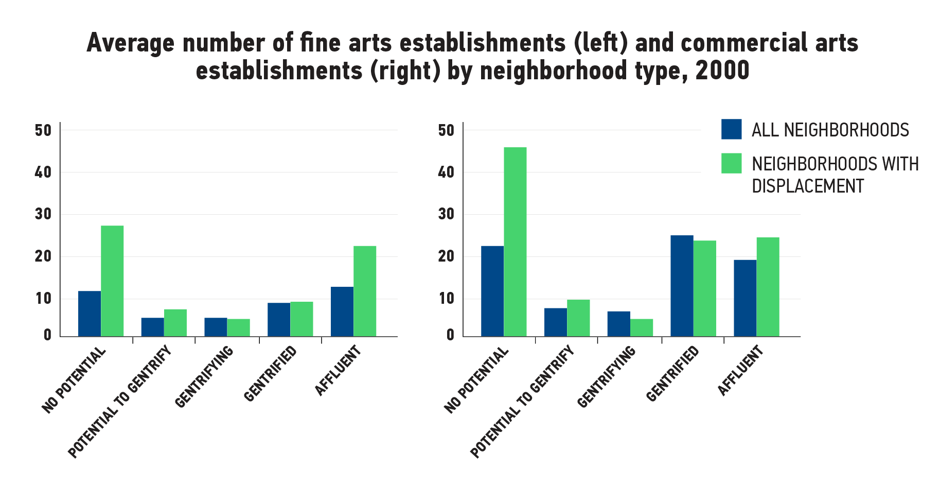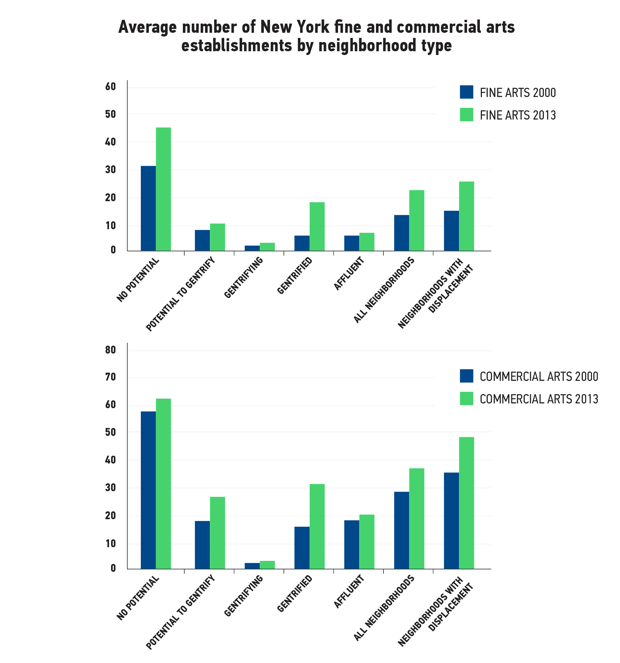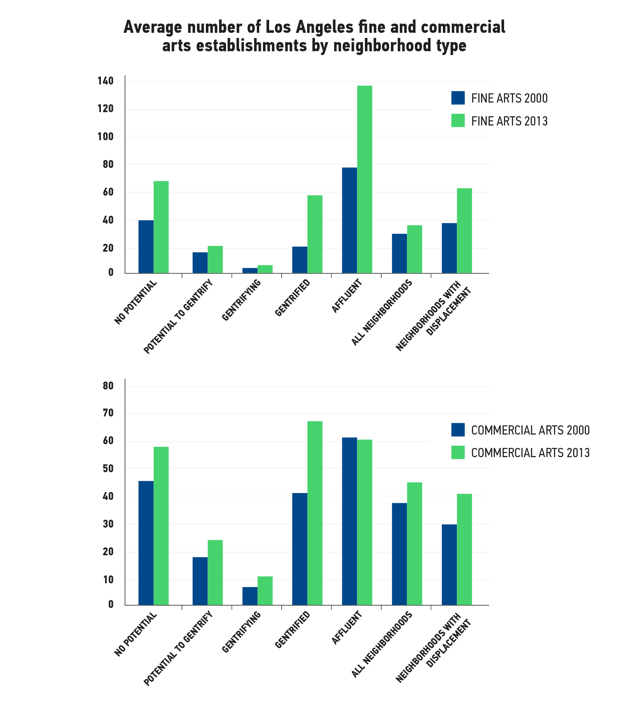Do Art Scenes Really Lead to Gentrification?
A new study finds that arts establishments are actually more concentrated in affluent and gentrified—rather than gentrifying—neighborhoods.
It’s an old story, the stuff of urban legend and conventional wisdom: First come the artists, then come the yuppies. But is this really the case? Are artists the “shock troops” of gentrification?
A new paper in the journal Urban Studies takes a deep dive into the connection between arts and gentrification. The paper explores this connection at the ZIP-code level for 30 large metropolitan areas with populations of more than 2 million people. It looks at the years between 2000 and 2013, a period of intense gentrification in some cities. And it considers the effects of both the fine arts—including independent artists, art galleries, fine arts schools, museums, and performing arts companies—and the commercial arts, such as the film, music, and design industries.
In their study, the researchers—Carl Grodach of Queensland University in Australia, Nicole Foster of the University of Texas at Arlington, and James Murdoch of the University of Texas at Dallas—separate neighborhoods (i.e., ZIP codes) into five categories: “affluent,” “already gentrified,” “gentrifying,” “potential to gentrify,” and “no potential to gentrify.” They designate a neighborhood “affluent” if it was in the top 20 percent of income areas at the beginning of the study period. A ZIP code counts as “gentrifying” if, between 2000 and 2013, it experienced an increase in the percentage of over-25-year-olds with a bachelor’s degree or higher that was equal to or greater than the metro-area increase, as well as an increase in median housing value during the same timeframe.
“Gentrified” ZIP codes are ones that followed the same trajectory as “gentrifying” ones, but also had either a median housing value or a median household income in 2013 that was higher than the metro average. ZIP codes are classified as having the “potential to gentrify” if their median income was less than the metro median in 2000, and if the percentage of new housing built in 1980 or later was less than the metro average in 2000.
Areas deemed to have “no potential to gentrify” were, in a sense, middle-class. They were not affluent, but they were above the metro median in terms of both income and housing construction in the year 2000.
Contrary to the popular narrative, the study finds that fine arts and commercial arts establishments were both much more concentrated in affluent areas, places that had already gentrified, and even in ZIP codes that had no potential to gentrify. Gentrifying neighborhoods actually had the smallest concentration of, and slowest growth in, arts establishments.
The chart below establishes a baseline for the year 2000. The pattern is similar for both fine arts and commercial arts: There are more of each type of establishment in affluent and already gentrified neighborhoods, on the one hand, and neighborhoods with no potential to gentrify, on the other.

Displacement is a contentious issue related to gentrification. The study looks at the effects of the arts on displacement in the five key neighborhood types. Again, we see the same kind of bifurcation. Displacement is highest in already gentrified and affluent neighborhoods, on the one hand, and in neighborhoods with no potential to gentrify, on the other. The lowest levels of displacement are in gentrifying neighborhoods and those that have the potential to gentrify.

The next set of charts looks at the connection between the arts, gentrification, and displacement from 2000 to 2013. Here, the pattern is different. Fine arts establishments are significantly over-concentrated in already gentrified and affluent neighborhoods. Commercial arts establishments, however, are most concentrated in already gentrified neighborhoods, followed closely by gentrifying neighborhoods. They are least concentrated in affluent neighborhoods. Ironically, it is these, more market-driven arts organizations—not art galleries and non-profit arts groups—that appear to be seeking out neighborhoods with cheaper rents.

These are general patterns across very different types of cities and metro areas. But do they hold true for expensive, superstar cities like New York in comparison to, for instance, less expensive Sunbelt metros?
To answer this, the study looks in more detail at four specific metros. Two of them are expensive superstar cities, New York and Los Angeles, which also are home to the nation’s most developed arts scenes. The other two, Chicago and Dallas, are less expensive, and have solid, but not nearly as extensive, arts and culture sectors.
Generally speaking, the trends in these metros follow the overall pattern: Arts establishments tend to locate in already wealthy, already gentrified areas. But there are some differences as well.
New York is the most commonly cited example of arts-led gentrification, the city that artists such as Spike Lee, David Byrne, and Patti Smith have accused of pricing out artists and the poor alike. However, ZIP codes with no potential to gentrify had the highest concentration of artists in New York. This was true of both fine arts and commercial arts, in both 2000 and 2013. But there was also a high concentration of arts establishments in neighborhoods experiencing displacement.
That said, the study finds little evidence that the arts are spurring gentrification in New York. Gentrifying neighborhoods had the smallest concentration of arts establishments in the city.

In Los Angeles, arts establishments were highly concentrated in affluent neighborhoods and already gentrified ones, and they were slightly less concentrated in neighborhoods with no gentrification potential. But again, gentrifying neighborhoods had the smallest concentration of arts establishments.

In Chicago and Dallas, we also see a bifurcated pattern, with arts establishments concentrated in already gentrified and affluent ZIP codes, on the one hand, and in ZIP codes with no potential for gentrification, on the other. There were much smaller concentrations of arts establishments in both gentrifying areas and those with the potential to gentrify.
When all is said and done, the study finds little evidence that the arts spur gentrification. Both fine and commercial arts establishments tend to cluster in long-established, affluent, and previously gentrified neighborhoods. Indeed, they are least likely to be found in gentrifying neighborhoods. Or, as the authors aptly put it, “while arts growth does occur in the context of gentrification, an arts presence is not driving the relationship. Rather, gentrified environments lead to arts growth.”
Ultimately, the paper suggests that the conventional narrative on arts-led gentrification has it backwards. In most places, artists and arts establishments have little to do with gentrification. It is gentrification that draws the arts, and not the other way around.
